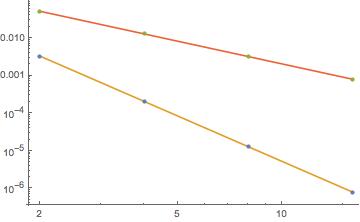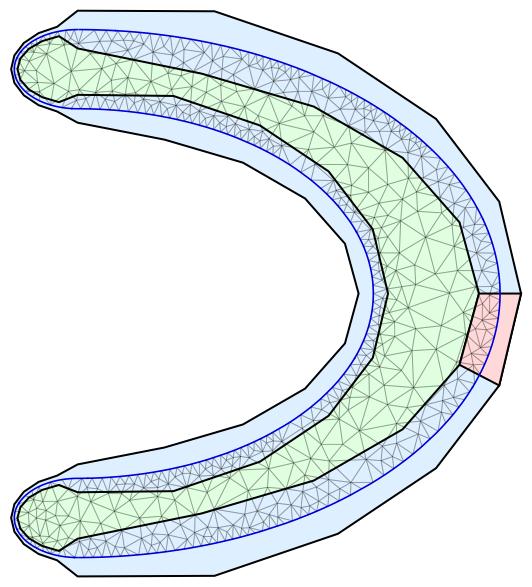Nt = 10; Rf = 2;(* Resampling factor *) Stf = 1/4;(* Scafolding thickness factor *)
coordsOuter = {}; coordsInner = {}; For[i = 1, i <= Nt, i++, l = Stf (Norm[Bcoords[[ci[i, Nt]]] - Bcoords[[ci[i - 1, Nt]]]] + Norm[Bcoords[[ci[i + 1, Nt]]] - Bcoords[[ci[i, Nt]]]])/4;2; (* choose size of scaffolding similar tousing distance to neighboring points *) tv = tanVecs[[i]]; n = {tv[[2]], -tv[[1]]};(* n = t x Overscript[z, ^] *) AppendTo[coordsOuter, Bcoords[[i]] + l n]; AppendTo[coordsInner, Bcoords[[i]] - l n]; ];

EDIT: Here a nontrivial space curve to demonstrate the method works generally.
xyE[θ_, el_] := {el Cos[θ], Sin[θ]}; xy[t_, wf_, el_] := Module[{θ}, Which[ 0 <= t < Pi/2, θ = 2 t - Pi/2; xyE[θ, el], Pi/2 <= t < Pi, θ = 2 t - Pi/2; (1 - wf)/2 xyE[θ, el] + {0, (1 + wf)/2}, Pi <= t < 3 Pi/2, θ = 5 Pi/2 - 2 t; wf xyE[θ, el], 3 Pi/2 <= t <= 2 Pi, θ = 2 t - 5 Pi/2; (1 - wf)/2 xyE[θ, el] - {0, (1 + wf)/2} ] ]; xyEP[θ_, el_] := {-el Sin[θ], Cos[θ]}; xyP[t_, wf_, el_] := Module[{θ}, Which[ 0 <= t < Pi/2, θ = 2 t - Pi/2; 2 xyEP[θ, el], Pi/2 <= t < Pi, θ = 2 t - Pi/2; 2 (1 - wf)/2 xyEP[θ, el], Pi <= t < 3 Pi/2, θ = 5 Pi/2 - 2 t; -2 wf xyEP[θ, el], 3 Pi/2 <= t <= 2 Pi, θ = 2 t - 5 Pi/2; 2 (1 - wf)/2 xyEP[θ, el] ] ]; wf = 0.7; el = 1.6; xy[t_] := xy[t, wf, el]; xyP[t_] := xyP[t, wf, el];
Set global parameters
Nt = 40; Rf = 3;(* Resampling factor *) Stf = 1/4;(* Scafolding thickness factor *)
Visualize the result like before:
ii = 5; Show[ Graphics[{{EdgeForm[Thick], LightBlue, POuter}, {EdgeForm[Thick], LightGreen, PInner}, {EdgeForm[Thick], LightRed, getPoly[ii, ii]}}], ParametricPlot[xy[t], {t, 0, 2 Pi}, Axes -> False, PlotStyle -> Blue], meshS["Wireframe"["MeshElementStyle" -> EdgeForm[Thin]]]]



